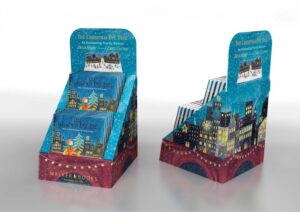Packaging is ubiquitous in our society. We use it for protecting, packing, shipping, labelling and advertising. When we consider the abundance of formats and designs available, it is quite right that we should have concerns about sustainability and the environment. Unfortunately, it is these initial concerns which have perpetuated a negative dialogue on our industry for more than two decades.

It’s worth taking a moment to consider every form of packaging you have encountered throughout your day. Did you eat a pre-packed sandwich for lunch? Did you have a product delivered and need to break through various layers of packaging to get to it? Alternatively, are you a manufacturer that has made a decision to pack your product in a certain case? Or maybe you are a graphic designer who has created the artwork used on that case, the complexity of which has determined or limited your material substrate options? These are the questions we should be asking ourselves when we think about packaging.
So, why should we be thinking about packaging?
We all have an impact on the types of packaging that we encounter every day. We have the ability, through our buying habits, work and knowledge, to shape the modern packaging industry and help tackle the sustainability issues which are wrongly seen as synonymous with our sector. The packaging sector has sales of £11 Billion, employs 85,000 people and that accounts for 3% of our total manufacturing workforce here in the UK. This is why we should be thinking more selectively about our packaging options, rather than engaging in a common negative dialogue that paints all packaging in a bad light. With the packaging industry rapidly expanding it is also an important time not only to think about, but to discuss these issues.
What are the reasons for the continued growth of the industry?
Since the millennium, there has been a perfect storm of circumstance to grow the packaging market exponentially. The landmark WPO (World Packaging Organisation) study of 2008 lists the various factors that have exasperated this explosion in packaging growth:
- The ageing of the world population
- The trend towards smaller households
- The increasing requirement for convenience among consumers
- Rising health awareness among consumers
- The trend towards ‘on-the-go’ lifestyles among increasingly time-poor consumers
- Growing requirements for brand enhancement/differentiation in an increasingly competitive environment
It seems undeniably apparent that since 2004, these drivers of packaging demand have only increased. Concerns from the consumer, and from companies who utilise packaging responsibly, will have no doubt been increased respectively. Therefore how we store, ship and protect our products has rightly become more and more important.
Do consumers care about packaging?
It is unfair to tar every packaging type with the same “environmentally unfriendly” brush, and studies such as Hartman Group’s 2009 Sustainability (3) show that the consumer is becoming more familiar, yet not totally au fair, with the factors that differentiate different forms of packing in terms of sustainability. Consider the conclusion drawn by the Hartman Group that 67% of consumer respondents were interested in packaging made from recycled materials yet only 25% could name a sustainable product. This suggests it is vital in the consumer’s eyes that packaging is sustainable, however more work should be done to educate and inform on what makes sustainable packaging. Less visible to the consumer is transit packaging; however we would make the case that it is part of a company’s CSR to ensure this part of the supply chain is as sustainable and environmentally friendly as possible.
What makes cardboard so sustainable?
The paper industry, specifically corrugated board, has been one of the forerunners in sustainability and environmental protection since the 1990s and before, far preceding the now commonplace environmentally conscious consumer. There are a number of reasons for this, but centrally, supply of raw material for paper production has been a significant driver in both the recycling and sustainability of this industry. Before exploring this in depth it is worth briefly outlining the process for manufacturing corrugated board.
Corrugated board is essentially a number of sheets of paper glued together using a natural starch glue. This paper, commonly thick and brown, starts its life in the same way as any paper. Wood pulp is used to create the sheets in a paper mill, these are then rolled and shipped to a corrugator. The sheets are then glued together by the corrugator with 3 sheets forming an inner, outer and fluted central layer used to create depth and strength.
This process transforms paper into a strong and rigid material. We are all familiar with the use of corrugated cardboard in large boxes, however the applications of corrugated board are endless and suggest that as widely used as it is, in shipping and product protection, corrugated is still not utilised as often as it could be. Just a few google searches can show the wide variety of applications of corrugated board and many design options for packaging products, merchandising products and creating incredibly complex structures.
Sustainability of supply
As we mentioned earlier, the raw material is key to the sustainability of this industry. There is a voluntary code of conduct closely followed in the paper production industry in both Europe and the US whereby only softwood trees from sustainable sources are used. To take the US as an example forestation is currently increasing as trees are constantly planted to support the industry. In 2003 the growth to removal ratio in the US was 1.74 meaning 74% more trees were planted than removed, this means trees are left to act as a CO2 sink and aid biodiversity. These initiatives have been a great success in both the US and Europe.
The ability to reuse and recycle corrugated board is also key to its environmental chops. In terms of re-use, anyone who has moved house will use a variety of old boxes that used to be used for holding products. When it does come time to recycle rather that reuse, it is possible to completely break down the board into its component materials. This means that 54% of of the pulp used in paper manufacture in Europe comes from recycled materials. At Garthwest even though we are manufacturers of new corrugated products we try to ensure as much of our paper used is made from recycled materials. It is this level of recycling efficiency combined with the rate at which trees, the source of fresh material, are used and replanted, that creates such a sustainable model in the cardboard industry.
What are the conclusions for business?
We think the increasing trend in packaging usage is here to stay and that this is not a bad thing in of itself. The selection of the material used for all types of packaging is what will determine whether our usage is sustainable or not. Where the challenge lies for business is in convincing the consumer that our increased use of certain materials is not an issue both in terms of sustainability and harm to the environment. The changing buying habits of consumers and how much this is influenced by the amount and type of packaging surrounding a product should be the main driver here. Going back to the Hartman group study, 88% of consumers now consider themselves to be engaging in sustainable behaviours, and this will be one of the main contributing factors in buying decisions. Therefore there needs to be a greater concern from businesses about choosing the correct packaging and then educating the consumer in sustainability. The areas in which corrugated board can replace other less sustainable materials used in primary product packaging needs to be examined often and where possible the use of corrugated containers in shipping needs to be increased and advertised. There is also an argument for using more corrugated board for merchandising and promotional applications such as displays, partially due to its respectability, but also as it is a fantastic material for these items. In conclusion we as an industry have the solution to the problems inherent in packaging for a global economy. However we need to be intelligent in our application and uptake of materials.



